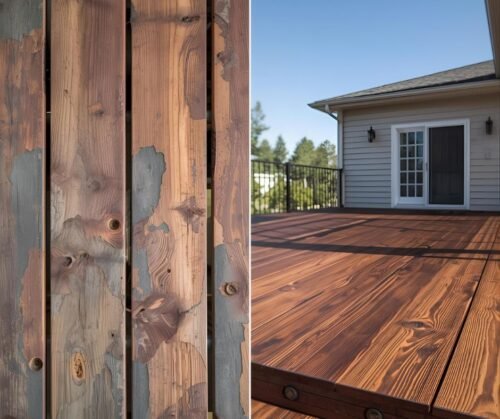
Insulating Windows and Doors: Save on Heating Costs This Winter
October 15, 2025
Insulating Windows and Doors: Save on Heating Costs This Winter
October 15, 2025
Winterizing Your Deck and Patio: Tips for Canadian Homeowners
How to protect wood decks, outdoor furniture, and railings from snow and freezing rain
Written by : Ati Rezaei
Prepare your deck and patio for Canadian winters to prevent damage and reduce spring repairs .
In Canada’s freeze–thaw cycles, generic “cover it and shovel” advice isn’t enough. What preserves a deck is measurable moisture control, correct film build on coatings, fastener metallurgy, drainage geometry, and material-safe de-icers. Our team at Renomod prepares decks with climate-specific methods so spring arrives with intact finishes and tight hardware—not warping and rust.
1.Why Winterizing Matters
Freeze–thaw cycles drive moisture into wood fibers and fasteners. The result: cupping, splintering, peeling finishes, and rusted brackets. Proper winterizing preserves structure, reduces slip hazards, and extends the life of stains and hardware.

2.Inspect and Clean Before the Freeze
Start with a thorough inspection: loose boards, popped nails/screws, wobbly railings, clogged gaps between boards, and blocked drains. Then clean: sweep debris, wash organic buildup (algae, leaves), and let surfaces dry completely before sealing.

3. Seal and Stain: Moisture Defense for Wood Decks
Use a high-quality, cold-climate exterior stain or clear sealer with water-beading performance. Focus on board ends, cut edges, and stair treads. Apply in dry weather above 5–10°C; allow full cure time before snowfall. Recoat intervals vary by product (typically 1–3 years).

4. Hardware and Railings: Rust and Wiggle Control
Tighten all fasteners and replace corroded ones with stainless or coated deck screws. Check railing posts and brackets for movement; reinforce as needed. For metal railings, clean and spot-prime exposed areas to prevent winter rust.

5. Protect Outdoor Furniture the Right Way
Use breathable, fitted covers or store furniture in a dry area. Avoid trapping moisture under plastic tarps. For wood pieces, apply outdoor oil or sealant; for cushions, clean and fully dry before storage to prevent mildew.

6. Snow and Ice Management (Without Surface Damage)
Use a plastic shovel and push with the grain of the boards; avoid metal edges. For ice, choose calcium magnesium acetate or pet-safe ice melters compatible with wood/composite and nearby stone. Avoid rock salt on natural stone and sealed wood—it stains and degrades finishes .

7. Anti-Slip & Lighting: Performance, Not Guesswork
Add anti-slip treads on stairs, ensure lighting is functional, and consider a textured sealer or grit additive on high-traffic zones. Keep walk paths clear to minimize slip risks during freeze–thaw swings.

8. When to Call a Professional
Extensive peeling, soft spots, loose posts, ledger issues, or water pooling near the house warrant a professional assessment. A quick service visit can prevent structural damage and ensure codes and safety are met before deep winter.

✅ Final Thoughts
A well-winterized deck weathers snow and freezing rain with confidence—and saves you from costly spring fixes. If you want expert prep, sealing, and safety upgrades, we’re ready to help
📞 Book a winterization visit with Renomod (inspection, coating, drainage, hardware, safety).

